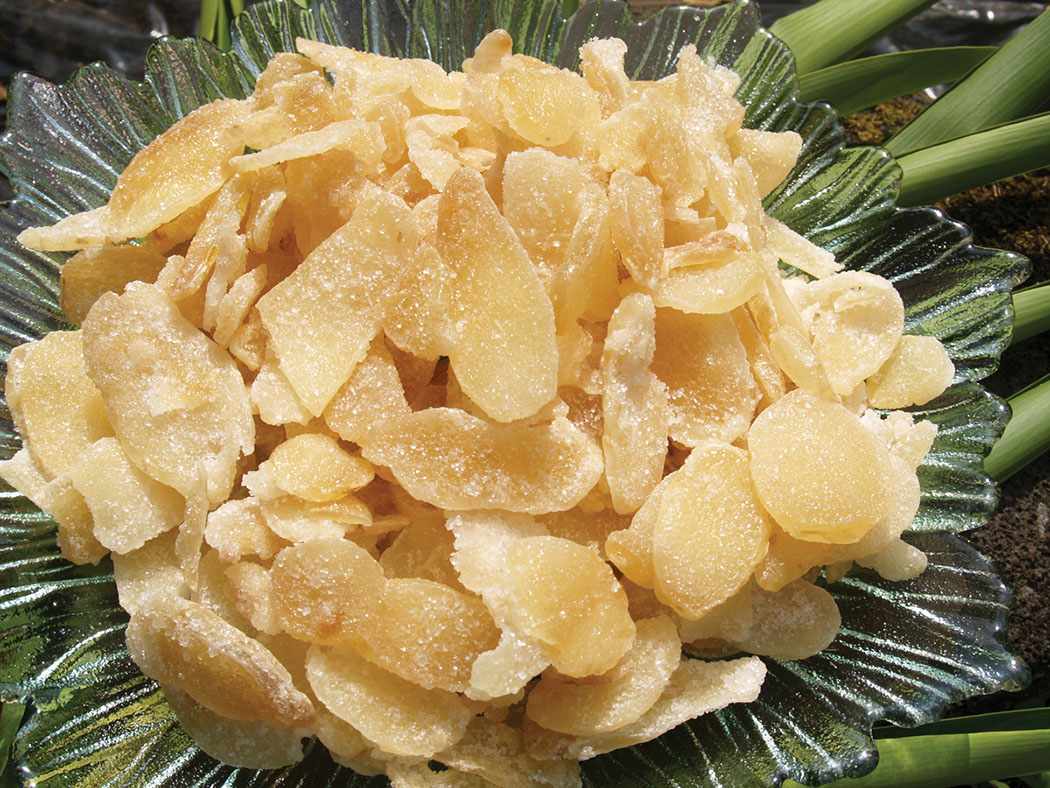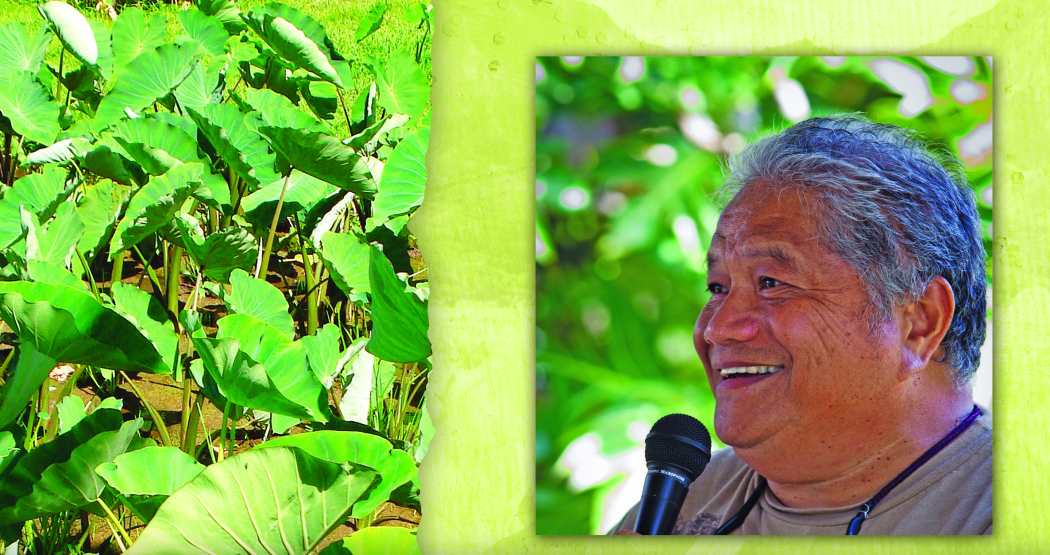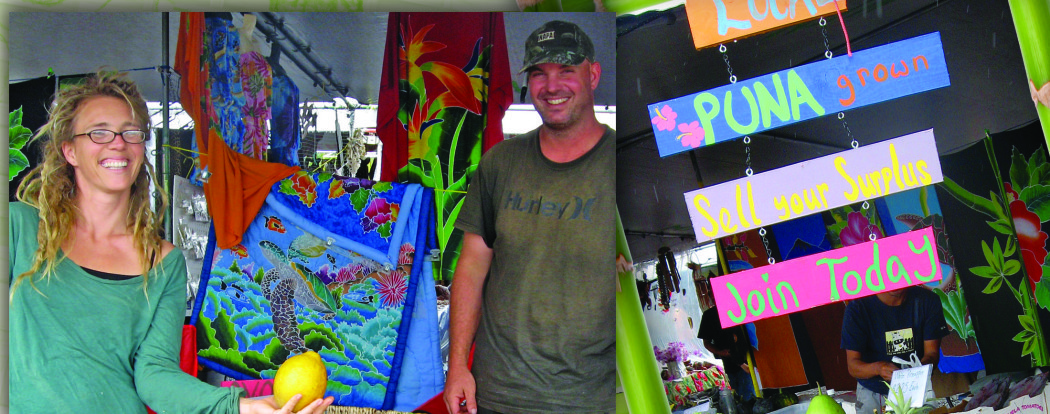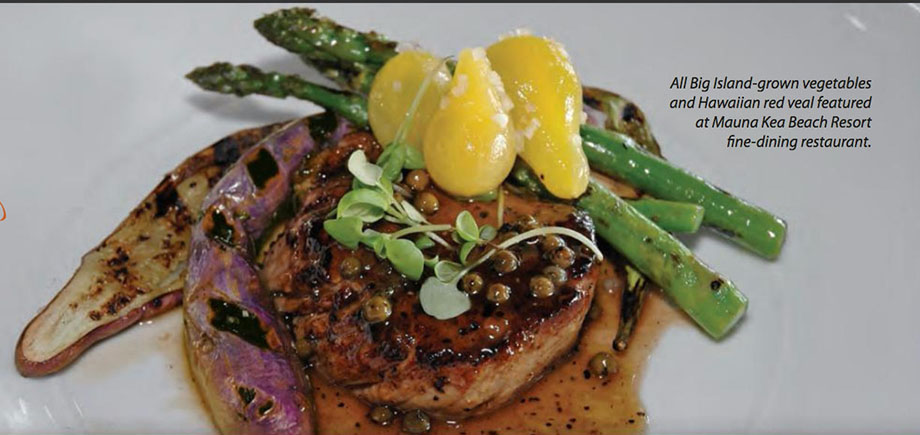
Ginger

By Sonia R. Martinez
If I had to guess what item is bought most often at any of our Hawai‘i Island farmer’s markets, I would say, fresh ginger.
Although edible ginger (Zingiber officionale) is found today growing in many tropical parts of the world, this member of the Zingiberaceae family originated in South Asia.
There are many small ginger farms located on Hawai‘i Island and most of them seem to be located in or around Puna and the lower Hāmākua areas.

The edible ginger is a fragrant and spicy rhizome used widely in Asian, Indian, Middle and Near Eastern, and West Indian cuisines. Other members of this family are turmeric, cardamon, and galangal.
Edible ginger acts as an antibacterial compound, a food preservative, and has both culinary and medicinal properties. It has been found to alleviate or prevent nausea, morning sickness, motion sickness, queasiness of the stomach. It stimulates gastric juices for better digestion and soothes the irritations of colds and coughs.
When shopping for ginger, look for smooth, firm, light brown or tan skin with no wrinkling or softening.
Besides adding as a spice or condiment to a dish, ginger can be used in many different ways.
Brewed tea: slice ginger, (no need to peel), place in a stainless mesh tea ball and add to water in a pan, bring to a boil, turn off heat and let it steep for about 10-20 minutes (longer if you want a stronger taste); pour into cup, add honey if desired. Brewed ginger tea is wonderful for sore throats or when you feel a cold coming on or for queasy stomach It is also delicious as iced tea. Lemon or lime juice may be added if you wish. Thrifty hint: Don’t discard the pieces of ginger after just one use. You can use it several times, although each time you brew the strength will be just a little bit less.
Candied: an old-fashioned delicacy. See recipe next column.
Baking: When making gingerbread cookies, cakes and other confections, try using fresh instead of ground. Although the taste is somewhat different from commercially-ground ginger, the fresh can be substituted. Use 1 tablespoon fresh to ¼ teaspoon ground.
Storing or Preserving
 Both fresh and mature ginger roots can last a long time. To prolong its life there are several ways of storing or preserving:
Both fresh and mature ginger roots can last a long time. To prolong its life there are several ways of storing or preserving:
Frozen: In plastic bags or wrapped in foil for long periods of time in the freezer. Just take out a piece as needed, rewrap tightly, and store again.
Sherried: Peel, cut in chunks, and store in tightly lidded glass jars filled with dry sherry (the ‘drinkable’ sherry, not the so-called cooking sherry). The sherry will absorb the taste of the ginger and can be used in sauces, stir-fries, soups, stews, beans, and other dishes.
Minced: Since so many recipes call for equal portions of minced ginger and garlic, I like to mince or grate larger quantities than needed for a recipe, mix the two and store in a tightly sealed glass jar in the refrigerator and use as needed. This saves a lot of time when you are preparing a recipe that calls for just a little bit of both.
Pickled: Young, tender ginger can be preserved as pickled ginger by peeling the outer thin ‘skin,’ slicing paper-thin and storing in vinegar. Pickled and preserved ginger does best stored in glass containers in the refrigerator.
Candied: Crystallized or candied ginger should be stored in airtight containers in a cool dark place for about three months. I have been able to keep it much longer when stored in doubled-sealed plastic bags in the refrigerator vegetable bin.
Ultimate Crystallized Ginger
The secret is steaming the ginger, instead of par-boiling it in water. The ginger will be tender and moist, with maximum flavor.
- Fresh ginger root (peeled larger pieces, 1/8 inch slices)
- Granulated Sugar
- Water
- 7-Up (or similar citrus soda)
Steamer (can be any kind)
Slow cooker or electric roaster (for larger batches)
Two wire racks – to drain and dry the sliced ginger pieces
Immerse the sliced ginger completely in a solution of 1/2 water and 1/2 citrus soda in a mixing bowl for a few minutes. This keeps the ginger from darkening.
Drain and arrange the ginger slices in stacks. Lay several stacks on their sides in the bottom of the steamer basket until the entire bottom of the basket is covered. Repeat with a second layer, and third, if needed. Place the steamer basket over simmering water, cover, and allow to steam for 30-40 minutes or until the ginger is quite tender.
Make a light simple syrup. For each cup of sliced ginger, use 1 C water and 1-1/2 C granulated sugar. Bring this mixture to a boil to dissolve the sugar, and then add with the sliced ginger in a crock pot at low temp. Cook gently for 6-8 hours, stirring occasionally. The ginger should be very tender. If not, continue simmering.
When tender, cool for 30-40 minutes. Remove the slices from the syrup with tongs and place them, without overlapping, on a wire rack (over a sheet pan or parchment or wax paper to catch drips). Allow the slices to dry until “tacky” (should not stick to a finger pressed onto a slice then lifted.)
Tip: Strain the syrup and save for use in cooking, drinks, fruit salads, etc. It’s yummy over peach ice cream.
Coat the ginger slices with granulated sugar. Use a container with a fitted lid or a zip lock bag. Place the coated slices on a clean drying rack.
Leave the sugared slices to dry overnight. Test for doneness by squeezing two slices together—if they do not stick together, they are finished. Store preserved ginger in airtight plastic or glass containers with screw or snap tops. Do not use recloseable plastic bags.
Original Source: Andie Paysinger
Photos by Sonia R. Martinez
Contact writer Sonia R. Martinez: SoniaTastesHawaii.com


